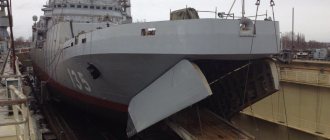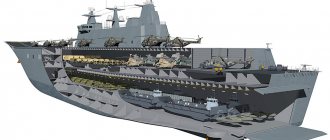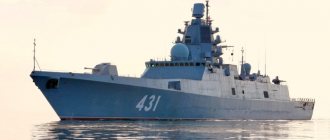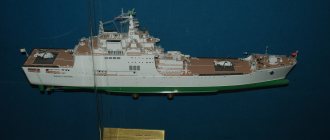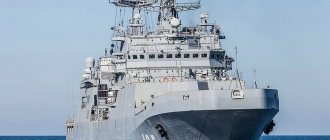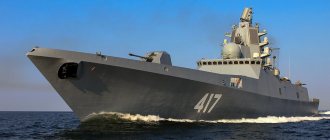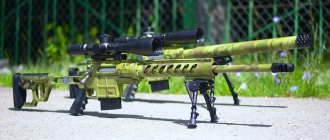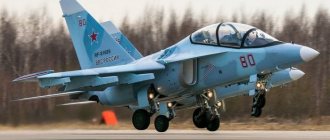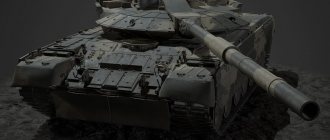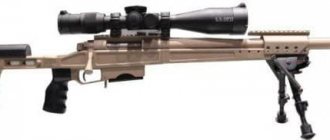Project 1144 nuclear cruiser "Orlan"
- country Russia
- length: 250 m
- width: 28.5 m
- displacement: 25,860 t (full)
- crew: 1035 people
“Peter the Great” - this is the proud name that today’s only heavy nuclear-powered missile cruiser of Project 1144 “Orlan” bears (a total of four such ships were built). Project 1144 is iconic in every sense. Now "Peter the Great" is the largest warship in the world, not counting aircraft carriers. But the cruiser is famous not only for its size. In open combat, it is superior to any non-aircraft carrier. P-700 Granit cruise missiles with a range of up to 625 km pose a threat even to aircraft carriers (although, to be honest, the ship itself is a convenient target due to its size). Soon, "Peter the Great" may receive new hypersonic missiles "Zircon", thus becoming even more dangerous.
“Peter the Great” / ©Interpolit
Russian Helicopter Carriers
At the moment, there is not a single helicopter carrier in service with the Russian Navy. The only copy was the Moskva PC, which remained in service with the Russian fleet until 1996.
After a change in the country's policy in the early 2010s, the Russian Federation ordered 4 Mistral-class UDCs from the French in 2011. It was planned to give the new type of ship the name “Priboy” (“Vladivostok” and “Sevastopol” are the names of the UDCs that were to be purchased from France). It was slightly modified from its French prototype. However, despite the fact that the first ship was already built in 2014, France refused to sell it due to the Crimean crisis.
"Surf"
Of course, this was not the most pleasant news for the Russian government, but on the other hand, it forced them to begin developing the construction of their own UDC. Thanks to the fact that engineers from both countries worked on the Mistral ships, the Russian Federation received the technology to build such sea giants. As a result, the UDC Avalanche project was presented at the Army 2015 exhibition. When compared with the Mistral, the domestic UDC will be slightly smaller in displacement, but will not be inferior in combat power. It is planned that the first combat ship “Avalanche” will be built in 2022.
America-class universal landing ships
- Country: USA
- length: 257.3 m
- width: 32.3 m
- displacement: 45,700 tons (full)
- crew: 1059 crew + troops
Universal landing ships, as you might guess, were created to conduct landing operations. But the Americans have greatly expanded this definition. The new America-class UDC is, in fact, a mini-aircraft carrier that is capable of carrying a solid aviation group of 22 fifth-generation F-35B fighters. These planes will take off from the deck using a short takeoff run, and they will land vertically. But there are other configurations: the UDC can carry many V-22 tiltrotors, which can deliver troops by air much faster than conventional helicopters. The lead ship of the USS America series (LHA 6) was introduced into the US fleet in 2014, and in total the Americans want to receive twelve such ships. In the future, they will replace the Wasp-type UDC.
UDC type "America" / ©Navsource
And American eagles do not fly in northern latitudes. And they don't swim
And this is not to mention the fact that the current US aircraft carrier and amphibious fleet turned out to be extremely poorly suited for combat operations in northern latitudes. Which, of course, has nothing to do with Iran, but is very important for us.
© navy.mil
American landing ship dock USS Gunston Hall.
Reference
During the largest NATO military maneuvers “United Trident 2018”, which took place in Norway and in the surrounding sea areas, an attempt to land an American operational-tactical landing force on the Norwegian coast was a complete failure. Two of the three main ships of the American amphibious group were damaged as a result of the storm and were unable to reach the landing area. At the same time, the American landing ship dock USS Gunston Hall (LSD-44) of the Whidbey Island class, having been caught in a storm in the Iceland area, received damage incompatible with further participation in the maneuvers. According to some reports, the ship hit an underwater rock. Dozens of crew members (as well as the Marines on board) suffered injuries, as well as soft tissue damage. Due to an emergency situation, USS Gunston Hall was sent to the port of Reykjavik. His fellow sufferer, the landing ship USS New York, also took refuge in the same port, the extent of damage to which the US Navy command kept secret.
At the same time, the nuclear attack aircraft carrier USS Harry S. Truman was forced to curtail its operations in this water area. The reason is still the same - bad weather conditions and the impossibility of safe flights of carrier-based aircraft.
© navy.mil
Nuclear attack aircraft carrier USS Harry S. Truman.
Wasp-class universal landing ships
- Country: USA
- length: 257.30 m
- width: 42.67 m
- displacement: 40,532 tons (full)
- crew: 1147 crew + troops
Until the advent of “America”, ships of the “Wasp” type had no competitors in their size among UDCs. They were created specifically to ensure transportation by sea and landing on an unequipped coast of an expeditionary marine battalion, the number of which could reach almost 1,900 people. The paratroopers can be supported by AV-8B Harrier II vertical take-off and landing combat aircraft (their number can reach 20). The Marines also have AH-1W Super Cobra attack helicopters at their disposal. At the rear of the Wasp there is a large room where equipment used for landing operations can be located. In total, the American fleet received eight such ships.
UDC type "Wasp" / ©Topwar
Flying robots won't help either
Another attempt to break out of the “vicious circle” of military ineffectiveness is being made literally before our eyes. We are talking about the launch of the US Navy program of so-called attack unmanned ships. The main advantage of which, according to their supporters, is that they will break into “restricted zones” even in situations that are pure suicide for ships with crew on board. However, a tempting, at first glance, unmanned concept, already at the stage of its comprehension in the United States itself, was subjected to merciless criticism.
© darma.mil
Unmanned ship Sea Hunter.
Sober-minded military experts point out the practical impossibility of using such an unmanned fleet against a military-technically developed country that has powerful electronic warfare capabilities. Such an adversary will be able to not only paralyze the electronic control systems of this unmanned fleet, but even take over this control and use these robotic ships to strike the US Navy itself. In passing, I note that this is not just a theory, but a completely effective practice. For example, Iran has repeatedly intercepted control of American drones and landed them safe and sound at its airfields.
Meanwhile, in the absence of guaranteed air cover, the US Marine Corps is also deprived of its offensive capabilities, for which landing on an enemy shore in such conditions would be a senseless act of suicide.
Clemenceau-class aircraft carriers
- country: Brazil
- length: 265.0 m
- width: 51.2 m
- displacement: 32,780 t (full)
- crew: 1338 people
In fact, aircraft carriers of the Clemenceau type were created not in Brazil, but in France, and back in the 50s. After the appearance of the much more modern Charles de Gaulle, they were removed from service, and one of the ships was transferred to the Brazilian Navy, where it continues to serve to this day. In Brazil, the ship was named "Sao Paulo". Even today, it remains a fairly formidable combat unit, which can carry up to 40 aircraft, including fifteen French carrier-based Super-Étendard attack aircraft.
“Sao Paulo” / ©Wikimedia
Aircraft carrier Charles de Gaulle
- country: France
- length: 261.5 m
- width: 64.36 m
- displacement: 42,000 tons (full)
- crew: 1200 people
This is the only nuclear-powered aircraft carrier of the French Navy: the authorities wanted to lay down another one, but this idea was abandoned, given the enormous cost of the warship. In any case, we have before us the largest European aircraft carrier. The basis of the power of this ship is the 4++ Rafale M generation fighters. In total, it can carry up to 40 aircraft. In terms of its combat potential, the Charles de Gaulle is inferior to American aircraft carriers (they are larger in size and can carry a larger number of winged vehicles). However, the Charles de Gaulle also repeatedly proved its combat capability, in particular during the operation in Syria. British aircraft carriers of the Queen Elizabeth class will soon displace the Charles de Gaulle: when they are commissioned, they will become the largest warships in Europe.
Aircraft carrier Charles de Gaulle / ©ZN
Project 1143 aircraft carrier cruisers
- country Russia
- length: 306.45 m
- width: 71.96 m
- displacement: 59,100 t (full)
- crew: 1980 people
Let us clarify: the definition of “project 1143” hides several subtypes of aircraft-carrying ships. Four of them (Kiev, Minsk, Novorossiysk, Baku) could use Yak-38 attack aircraft with vertical takeoff and landing. Subsequently, on the basis of Project 1143, the Project 1143.5 ship Admiral Kuznetsov was built, as well as two more aircraft-carrying cruisers (Varyag and Ulyanovsk), which received an expanded take-off deck and the ability to use aircraft with conventional takeoff and landing, such as the Su- 33. The fate of all these ships turned out differently. "Admiral Kuznetsov" became the only Russian aircraft carrier. But “Varyag” turned into the Chinese “Liaoning”. The ship "Baku" underwent modernization and joined the ranks of the Indian Navy under the name "Vikramaditya". “Ulyanovsk” was never completed, although conceptually it was the most advanced of the entire series: it had a steam catapult and, in theory, could use AWACS aircraft.
TAVKR "Admiral Kuznetsov" / ©Bastion-karpenko
US Navy amphibious assault teams
Universal landing ship / Photo: army-news.ru Brave American GIs are taking cities with the strength of one battalion of Marines!
Neither the lack of Coca-Cola, nor the delay in delivering pizza to the front line - nothing can break the morale of the American Marines. Steadfastly enduring the hardships and deprivations of military service, US soldiers crush an enemy ten times superior in strength and plant the Stars and Stripes flag (aka “mattress”) on the next Iwo Jima, Okinawa or the central At-Tahrir square in the glorious city of Baghdad. And what? The situation looks quite realistic. The Americans have everything they need to carry out such operations: a fleet of universal landing ships, special landing craft, helicopters, high-speed hovercraft, amphibious tanks and four divisions of selected thugs equipped with the most modern weapons. There is even a special term - amphibious landing group (ADG) of the US Navy. A powerful and compact tool for “projecting power” anywhere on the planet.
Universal landing ship!
A modern “Noah’s Ark” capable of transporting and landing marine forces on an equipped or unequipped enemy coast. Its enormous autonomy and cruising range allow the UDC to operate independently on the other side of the Earth, and the presence of two to three dozen aircraft on board allows it to land combat groups deep in enemy territory, providing solid fire support to the landing forces.
UDC is not just a landing ship. This is the command center of the entire operation - the headquarters and combat information center, where all information about the current situation in the landing zone flows. An admiral's cabin, many satellite communication channels, dozens of operator and communications stations... The universal landing ship provides fantastic opportunities for managing landing operations.
UDC is a comfortable floating hospital designed to accommodate hundreds of victims of combat operations, accidents and disasters. There are a dozen operating rooms on board the ship, in which the most complex surgical operations can be carried out simultaneously - the equipment of the medical units of the UDC would be the envy of any other coastal hospital.
UDC created a new format for conducting landing operations. Over-the-horizon landing allows the ship not to be exposed to the danger of shelling from the shore - during the landing, modern UDCs must be tens of kilometers from the enemy’s coast, remaining invisible to enemy radars and invulnerable to cannon artillery fire. Equipment and personnel are transported to the shore by speedboats and helicopters.
Finally, a modern UDC is equipped with a set of self-defense weapons capable of repelling random attacks from broken missiles, enemy aircraft and sabotage groups.
Boats, helicopters, armored vehicles, thousands of personnel, giant warehouses and storage facilities, a command center and a hospital - all this is one UDC. Power, efficiency and savings. One ship duplicates the tasks of ten ships. Is not that great?
No, that's not great. That's funny.
According to statistics, the required tonnage rate per paratrooper during World War II was 7 gross register tons. What does this number mean? Just ordinary human needs - to eat and drink. No dirty jokes.
On long hikes, there is a shortage of essentials - it is often difficult to find even fresh water suitable for drinking. Soldiers require a camp kitchen with all the necessary equipment. Tents, blankets, medicines. Hygiene products - you don’t want your platoon to turn into a herd of stinking animals, do you? Often, special equipment is required (from shovels and binoculars to laser target illumination equipment). Optional - air conditioning, Coca-Cola and mobile diesel generators.
Weapons and Ammunition. This is just a nightmare - for example, the supply standard of the Red Army of the 1941 model established 72 rounds per day for one 152 mm gun; in reality, in an intense battle, ammunition consumption exceeded the norm many times. In our case, thousands of artillery shells will have to be delivered far away!
It is no secret that the required consumption of material resources has increased many times over time - already during the Falklands conflict (1982), the tonnage rate per British paratrooper reached 50 gross registered tons. What do you want? Harsh weather conditions, long expedition on the other side of the Earth.
It turns out to be a simple proportion. Are there 2,000 Marines aboard the amphibious assault ship? Very good, immediately place three container ships with equipment, provisions and ammunition in the wake of the UDC.
It’s not hard to imagine how much fuel the gas turbine engines of the Abrams consume, how much fresh water do soldiers need in hot desert conditions, and do two, five, even ten thousand Marines have enough strength to carry out a major landing operation in modern conditions? However, more on this below.
UDC is the flagship! A common misconception, actively introduced into the philistine consciousness with the help of bright but meaningless phrases like “coordination, etc. In reality, when there is a need for centralized control of a large landing operation carried out by disparate forces of the Marine Corps, Air Force and Navy, special command ships come to the rescue.
In the Soviet Union, two obsolete Project 68-bis cruisers were converted for these purposes. “Zhdanov” and “Senyavin” lost some of their weapons; in return, the ships received an additional mast with antenna devices, a helipad, a printing house, comfortable cabins for senior command personnel, a cockpit for a musical orchestra and work areas of the headquarters operational post with a total area of 350 square meters. meters.
USS Mount Whitney is the headquarters ship of the US Navy's Sixth Fleet.
As for the US Navy, the Americans initially built specialized command ships of the Blue Ridge type. A smooth open deck with many antenna casings, a helipad, modern communication systems, equipped rooms for briefings and press conferences, as well as command posts where up to 200 officers and 500 junior rank specialists can work simultaneously.
Trying to “shove” all this equipment onto a universal landing ship means turning the UDC into an overly complex and unreasonably expensive structure, at the same time incapable of fully performing landing and headquarters functions.
The story with the “ultra-modern hospital” on board the UDC is completely similar to the story with the headquarters. Evacuation and medical care are always carried out by specialized hospital ships, whose activities are regulated by the Hague Conventions of 1899 and 1907.
Hospital ship "Irtysh", Pacific Fleet
Dozens of operating rooms, an infirmary with a thousand beds, an X-ray room, a medical laboratory, a pharmacy, functional research rooms, intensive care wards, a dental office, a morgue, oxygen stations... placing all this on board one UDC seems to be a very non-trivial task.
Finally, hundreds of victims have nothing to do on a warship - they must be urgently delivered to their homeland, while exposing them to as little danger as possible. The best solution is a special floating hospital that meets all the requirements of the Hague Convention.
White color, green stripe along the entire length of the hull, interrupted by three red crosses - the deliberate sinking of such a ship is regarded as a war crime. Whatever the skeptics say, the victims on board a hospital ship are many times more likely to reach their native shores than those who remained on board a universal landing ship.
As a result, instead of one “universal” landing ship, several specialized ships and vessels appear - container ships with equipment, headquarters and hospital ships...
But what about the escort? That's right, a dozen surface and underwater combat ships. And to them - a dozen naval tankers with fuel, fresh water and technical fluids. In addition, our squadron will need a floating workshop and several ocean tugs (rescue complexes) to evacuate damaged and damaged ships from the BD zone. Plus a couple of mine-sweeping ships... As a result, a gigantic formation of dozens of pennants emerges, which does not at all look like a “compact amphibious group.”
A living example - during the Anglo-Argentine conflict of 1982, British “sea wolves” drove a squadron of 86 warships and support vessels to the Falklands! (excluding the group sent to the island of South Georgia and the ships that ensured the transatlantic transition of the squadron).
Paradoxical but true:
1. There are no amphibious landing groups, because their existence in today's realities is, in principle, impossible . Landing operations are carried out by colossal forces of the army, air force and navy - this is a very expensive “game”, in which, in addition to dozens of warships, hundreds of support vessels are involved.
2. A universal landing ship (helicopter-dock), similar to the American Wasps and Tarawas, is empty bravado and a waste of funds . Exceptionally large, expensive and useless ships are unable to solve the task for which they were once created. They cannot capture even the smallest country (as they say, it’s not Senka’s cap), and their use in any of the modern conflicts is ineffective and unnecessarily wasteful.
The French-Russian Mistral, the Spanish Juan Carlos, the American San Antonio and their analogues look a little better - these ships are relatively modest in size and have an adequate cost, however, their scope of use is limited to colonial showdowns and pacifying riots of savages .
As for “serious” conflicts (“Desert Storm”, etc.), during them it is possible, and even necessary, to use the Mistral UDC. But it should be understood that the contribution of Mistral will be microscopic. UDCs do not solve anything in modern warfare; a completely different technique is required here.
But who are they, these mysterious conquerors, who make a decisive contribution to the transfer of Marine Corps forces? Who are these monsters that are capable of delivering a million-strong army to foreign shores in the shortest possible time? They are not shown at parades and in museums, films are not made about them and books are not written. The existence of these machines is the Great Mystery of the American Navy, which cannot be mentioned in the media. Therefore, instead of the real state of affairs, the Pentagon tells a fairy tale about “amphibious groups” and focuses the attention of listeners on other nonsense.
Sealift Command fast transports
A galaxy of 100 Leviathans that can bring democracy to any of the enemies of the State Department. The aircraft-carrying cruiser Admiral Kuznetsov (up to 300 meters in length, cargo displacement - more than 60 thousand tons) will envy their size. At the same time, the giants can quite lay claim to the “Blue Ribbon of the Atlantic” * - their speed goes beyond 20 knots, up to 33 knots for gas turbine ships of the Algol series!
* "Blue Ribbon of the Atlantic" - a prize awarded to the fastest transoceanic liners at the beginning of the twentieth century
Most of them have a civilian background - ordinary Dutch, Danish, British, South Korean (and even one Soviet!) container ships recruited for the needs of the American fleet. The Pentagon carefully monitors high-speed container ships, roll-off ships (vessels for transporting wheeled and tracked vehicles), dry cargo ships around the world and actively buys up examples of marine equipment that it likes. A period of intensive modernization (ramps and ramps, 110V electrical network, cargo booms and other special equipment) - and a nightmarish specter of war comes out into the ocean - a tank landing ship capable of delivering a hundred Abrams and tens of thousands of tons of other equipment in its holds in one voyage .
- Former name?
— "Laura Maersk"
- Place of Birth?
- Denmark.
- Who are you now?
— USNS Shughart (T-AKR 295), a 277-meter ro-ro carrier of the Sealift Command, the lead ship in a series of three units.
Among the Leviathans, slightly less epic, but no less useful units are periodically encountered - cable layers, tankers, submarine bases, oceanographic vessels and mobile landing platforms. Each vessel has its own clear purpose, while in peacetime, some of them sleep on mothballs, and sometimes perform tasks in the interests of civil organizations. By the way, the bulk of the crews of the Sealift Command are civilian sailors; military personnel appear on the decks of Leviathans only during trips to the combat zone.
It’s worth making a small digression here. Of course, the concept of the Sealift Command does not imply direct participation in landings on enemy coasts. One gets the feeling that the Yankees have completely abandoned the idea of large-scale amphibious assaults - in modern conditions, an attempt to attack head-on on an enemy shore is too complex and risky an operation that threatens to result in unreasonably high losses. Brave Americans act according to a different, well-worn scheme - they unload tanks at the port of the nearest friendly state, accumulate forces and... voila! A steel avalanche of armored vehicles poured across the border.
The target is Iraq? But why storm the Iraqi coast - let's carry democracy across the border of Saudi Arabia. Target – Syria? We'll drive across the Turkish-Syrian border. The target is Iran? We'll drive across the Iran-Iraq border.
This is where the need for “Leviathans” arises - in just a couple of months, giant transports will deliver thousands of armored vehicles, fuel, provisions, equipment and hundreds of thousands of army and marine personnel to the desired port. And then - war.
The giant fleet of Leviathans is the very means for “projecting power” in any corner of the planet. Only, unlike the cheap threats posed by amphibious groups, Sealift Command is actually CAPABLE of bringing democracy to any country in the world.
Comparing Leviathans to Mistrals, Wasps and Tarawas is simply insulting - UDCs are just puppies compared to these mutants. How much aircraft can fit on board the Mistral? 16 medium-sized helicopters?
Leviathan, without blinking an eye, will deliver 100 rotorcraft + spare parts, fuel and lubricants, ammunition and auxiliary equipment to the enemy shore.
Apache helicopters preparing for loading
The cargo decks of the Bob Hope military transport (by the way, one of the few that were originally built in American shipyards for a special order of the US Navy) are equal in area to eight football fields. This allows you to transport up to 900 trucks and Hummers at a time. To save time, the equipment is driven on board under its own power through the folded stern ramp.
Unloading can occur in several ways: through the stern and side ramps, using four cargo booms with a lifting capacity of 110 tons, or, if it is not possible to get close to the shore, using pontoon crossings or using mobile landing platforms MLP (tanks are transported to a ship moored to the side platform from where they are delivered by boats and barges to the shore).
Most Leviathans have equipped helipads (and even hangars) on the upper deck - all this further expands the capabilities of these giant cargo ships.
Unloading equipment using pontoons
MLP at work
Epilogue
The river of truth flows through the bed of error. Media reports about the arrival of the next amphibious landing group of the US Navy in the Persian Gulf are a dummy, a stun grenade, a hoax. The real war begins only after the Leviathans of the Sealift Command arrive in the intended combat area . This technology contains the entire strength of the American armed forces - power, mobility, speed of deployment.
It is from these gigantic transports that the greatest threat comes - without them, the US army would be locked, as if in a prison, on the North American continent and would not have the slightest opportunity to establish democracy outside its country.
Photo from the site
"Army Bulletin"
MOSCOW, "Army Bulletin",
Oleg Kaptsov 21
Original
